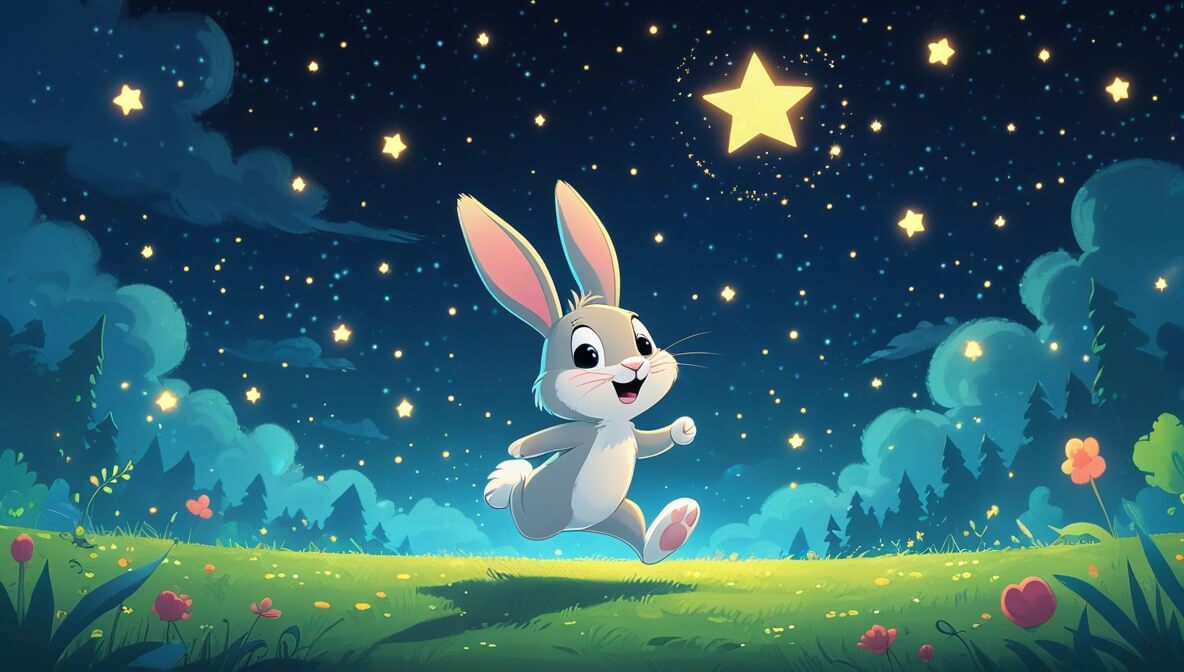In the quiet of the night, a small bunny named Flopsy discovers the magical world of twinkling stars. She embarks on a journey of friendship and wonder.
Age Recommendation
0 – 4 years
Characters
Characters:
- Flopsy (a curious little bunny with big ears and a warm heart)
- Twinkle (a playful star who loves to dance in the night sky)
Story
Flopsy the bunny lived in a cozy burrow with her family. Every night, as the moon rose, she looked up at the sky and wondered about the twinkling stars. One evening, she decided to hop into the meadow and see them up close.
The Twinkling Journey Begins
As Flopsy hopped along, she met a bright star named Twinkle. Twinkle danced joyfully in the sky, inviting Flopsy to join her. “Come play with us!” Twinkle called. Flopsy’s heart filled with excitement.
Reaching for the Stars
Flopsy tried to touch the stars, stretching her little paws toward the sky. Twinkle giggled and said, “You can’t reach us, but you can dance and play with us from the ground!” Flopsy laughed and began to hop in circles, her fluffy tail bouncing.
A Night of Friendship
The stars twinkled brighter as Flopsy danced. She felt a warm feeling inside, knowing she had made a new friend. Twinkle whispered, “We’ll always be here, lighting up your dreams.” Flopsy smiled, feeling loved and happy.
The end.
Moral of the Story
Friendship and imagination can bring joy and wonder to our lives, even when things seem far away or unreachable.
Questions to Think About
- How did Flopsy feel when she saw the stars?
- What made Twinkle special?
- Why is it important to have friends?
- How do you feel when you look at the night sky?
- What other magical things do you think are in the night sky?
Do You Know
- Stars are giant balls of gas that are very far away, but they shine brightly in the night sky.
- Bunnies have strong back legs that help them hop high into the air.
Word Explorer
- Twinkle: A little light that blinks in the sky.
- Meadow: A field full of grass and flowers.
- Burrow: A cozy home dug into the ground.
Emotions in the Story
- Curiosity: When Flopsy wanted to see the stars up close.
- Joy: When Flopsy danced with Twinkle.
- Friendship: When Twinkle and Flopsy shared a special moment.
Color Your Scene
Imagine Flopsy dancing under the night sky with Twinkle shining brightly above. Draw Flopsy with her big ears and fluffy tail, and use lots of glittery colors for the stars and the dark blue night sky.
Parents’ Corner
This story offers a wonderful opportunity to discuss the magic of friendship and imagination with your child. Encourage them to think about how friendships can make everyday moments special. Talk about the importance of using imagination to explore and learn about the world around them. Highlight how even the simplest of things, like looking at the stars, can become a magical adventure with a friend.











